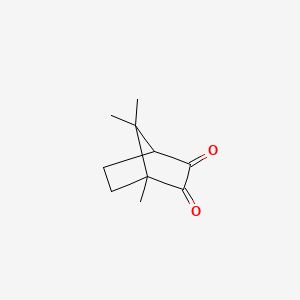| MeSH term | MeSH ID | Detail |
|---|---|---|
| Body Weight | D001835 | 333 associated lipids |
| Dental Leakage | D003763 | 5 associated lipids |
| Hemolysis | D006461 | 131 associated lipids |
Camphorquinone
Camphorquinone is a lipid of Prenol Lipids (PR) class. The involved functions are known as Polymerization. The related lipids are camphoroquinone.
Cross Reference
Introduction
To understand associated biological information of Camphorquinone, we collected biological information of abnormalities, associated pathways, cellular/molecular locations, biological functions, related genes/proteins, lipids and common seen animal/experimental models with organized paragraphs from literatures.
What diseases are associated with Camphorquinone?
There are no associated biomedical information in the current reference collection.
Possible diseases from mapped MeSH terms on references
We collected disease MeSH terms mapped to the references associated with Camphorquinone
PubChem Associated disorders and diseases
What pathways are associated with Camphorquinone
There are no associated biomedical information in the current reference collection.
PubChem Biomolecular Interactions and Pathways
Link to PubChem Biomolecular Interactions and PathwaysWhat cellular locations are associated with Camphorquinone?
There are no associated biomedical information in the current reference collection.
What functions are associated with Camphorquinone?
Related references are published most in these journals:
| Function | Cross reference | Weighted score | Related literatures |
|---|
What lipids are associated with Camphorquinone?
Related references are published most in these journals:
| Lipid concept | Cross reference | Weighted score | Related literatures |
|---|
What genes are associated with Camphorquinone?
There are no associated biomedical information in the current reference collection.
What common seen animal models are associated with Camphorquinone?
There are no associated biomedical information in the current reference collection.
NCBI Entrez Crosslinks
All references with Camphorquinone
Download all related citations| Authors | Title | Published | Journal | PubMed Link |
|---|---|---|---|---|
| Wang Z and Chiang MY | System compliance dictates the effect of composite filler content on polymerization shrinkage stress. | 2016 | Dent Mater | pmid:26916062 |
| Ge X et al. | Probing the dual function of a novel tertiary amine compound in dentin adhesive formulations. | 2016 | Dent Mater | pmid:26764171 |
| Zhang Y and Wang Y | The effect of hydroxyapatite presence on the degree of conversion and polymerization rate in a model self-etching adhesive. | 2012 | Dent Mater | pmid:22032933 |
| Prakki A et al. | Effect of propionaldehyde or 2,3-butanedione additives on the mechanical properties of Bis-GMA analog-based composites. | 2009 | Dent Mater | pmid:18757084 |
| Cadenaro M et al. | Influence of different initiators on the degree of conversion of experimental adhesive blends in relation to their hydrophilicity and solvent content. | 2010 | Dent Mater | pmid:20018363 |
| Ely C et al. | Polymerization kinetics and reactivity of alternative initiators systems for use in light-activated dental resins. | 2012 | Dent Mater | pmid:23083514 |
| Chen M et al. | Effect of a non-thermal, atmospheric-pressure, plasma brush on conversion of model self-etch adhesive formulations compared to conventional photo-polymerization. | 2012 | Dent Mater | pmid:23018084 |
| Guo X et al. | Effects of water content and initiator composition on photopolymerization of a model BisGMA/HEMA resin. | 2008 | Dent Mater | pmid:18045679 |
| Furche S et al. | Quantification of elutable substances from methacrylate based sealers and their cytotoxicity effect on with human gingival fibroblasts. | 2013 | Dent Mater | pmid:23570627 |
| Prakki A et al. | In vitro wear, surface roughness and hardness of propanal-containing and diacetyl-containing novel composites and copolymers based on bis-GMA analogs. | 2008 | Dent Mater | pmid:17688931 |
